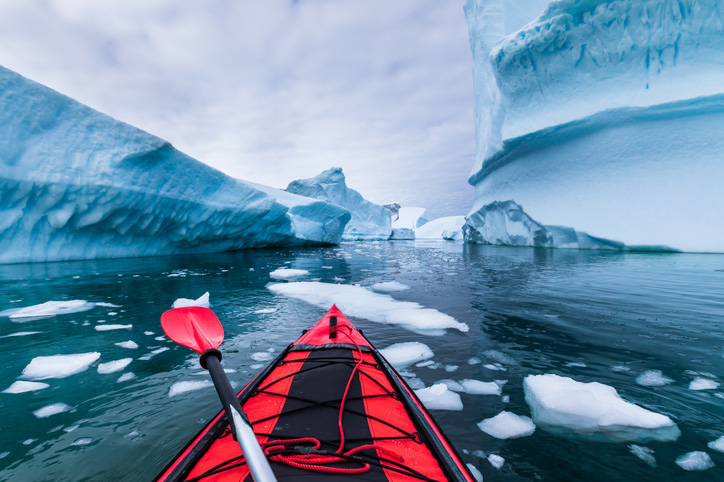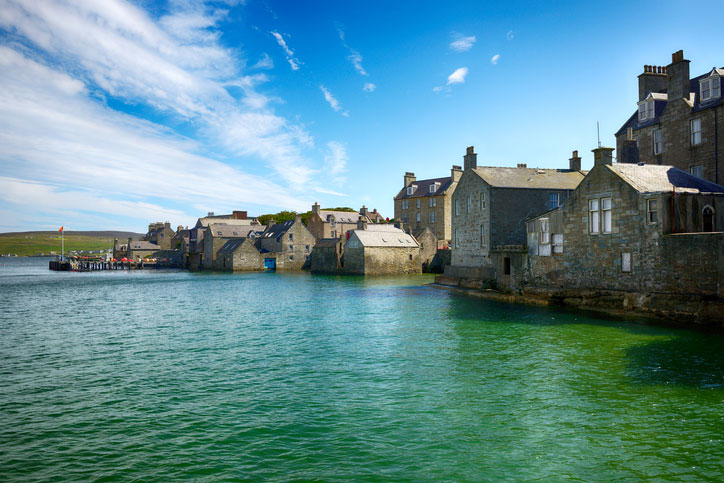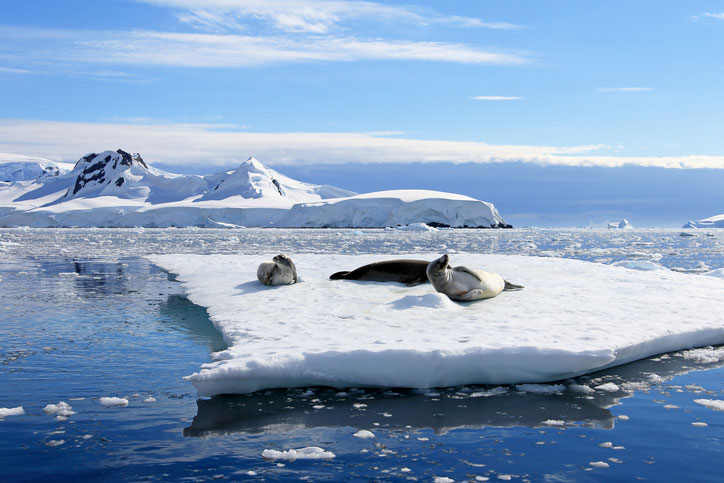Antarctica 2021 – Total Solar Eclipse on the Ice
November 20-December 21, 2021
A total solar eclipse is a rare event, occurring only once each year – if at all! – and to witness it in Antarctica is without doubt an even rarer occurrence. On this unique voyage, we will visit Antarctica and experience the incredible white continent in late spring; photograph glistening icebergs, witness thieving Adélie penguins stealing one another’s stones during nest-building – and even orca whales hunting in packs. It’s also a wonderful time to kayak and snowshoe through the pristine snow; and enjoy thrilling Zodiac cruises amongst sea ice and icebergs in the Weddell Sea.
Perched in a favorable position, we hope for clear skies and favorable weather conditions to witness the full solar eclipse. The 2021 eclipse in Antarctica is a total solar eclipse, which is only visible from a small area on Earth. Those who are able to see the total eclipse are in the center of the moon’s shadow when it hits Earth. A total solar eclipse is in itself special, but to experience it in Antarctica is truly a once-in-a-lifetime event.
In South Georgia – a wildlife hotspot unlike any other – we will encounter elephant and fur seal beachmasters aggressively defending their harems from younger competitors; young wandering albatross testing their enormous wings on their maiden flight; and walk amongst some of the largest king penguin colonies on Earth, listening to their trumpeting mating calls. For the adventurous few, it’s possible to retrace the steps of Shackleton, Worsley and Crean’s epic alpine crossing from King Haakon Bay to Stromness. We also plan to stop in historic Port Stanley, Britain’s remote outpost, on our return to Ushuaia.
Aboard the Sea Spirit; Providing spacious accommodations for over 100 passengers, the Sea Spirit also provides the maneuverability and friendly atmosphere of a small ship. An ice-strengthened hull, a fleet of rubber inflatable boats for landings on wild shores, an experienced crew, and a set of retractable fin stabilizers for smoother sailing make your polar expedition really deep, unforgettable and safe.



Tour Expert

Linda Shore
Executive Director, Astronomical Society of the Pacific
Itinerary
Expedition Highlights
- Once-in-a-lifetime opportunity to witness a total solar eclipse in Antarctica
- In South Georgia, retrace Shackleton’s legendary mountain crossing (on foot) – additional cost
- Glide past glittering grounded bergs on your kayaking adventures in Antarctica
- Encounter fur seal beach masters protecting their harem in ferocious battles in South Georgia
- Witness Adélie penguins nest-building, occasionally stealing rocks from their unsuspecting neighbors
In true expedition style, we encourage exploration and adventure, offering flexibility in challenging environments in a way that puts us among the action to see and do as much as possible. This itinerary is only a guide and subject to change due to ice and weather conditions.
Day 1 – Arrive Ushuaia
We arrive in Ushuaia, where we will be met by a representative of Aurora Expeditions and transferred to our downtown hotel (preferred flights only).
Day 2 – Embark the Sea Spirit in Ushuaia
This morning, enjoy a leisurely breakfast at the hotel before exploring Ushuaia on a half-day city tour.
Ushuaia, capital city of the province of Tierra del Fuego, is located on the shores of the Beagle Channel and it is surrounded by the Martial Range. This offers a unique landscape as a result of the combination of mountains, sea, glaciers and forest. The city tour will visit The Mission, Brown and Solier neighborhoods, where you can see old houses belonging to the first families in Tierra del Fuego, such as the Beban, the Pastoriza, and the Ramos. Later, we head 11 kilometres (6.8 miles) out of town to Martial Glacier. The ride in the chair lift to the trails leading up to the glacier provides wonderful regional views and of Ushuaia town, the Beagle Channel and its islands. Afterwards, we’ll continue to the End of the World Museum with exhibitions explaining the history of Tierra del Fuego.
Then we transfer to the pier where our expedition team will warmly welcome us on board the Sea Spirit at approximately 4pm (final embarkation time will be provided in the final documentation). As the Sea Spirit pulls away from port, we’ll gather on the deck to commence our adventure with spectacular views over Ushuaia and Tierra del Fuego. There will be time to settle into your cabin before our important briefings.
Day 3 – Drake Passage crossing
As we commence the Drake Passage crossing, we make the most of our time getting comfortable with the motions of the sea. Our expedition team will prepare for our first landing with important wildlife guidelines and biosecurity procedures, and start our lecture program to learn more about Antarctica’s history, wildlife and environment.
Our wildlife experiences begin as we enjoy watching and photographing the many seabirds, including majestic albatrosses and giant petrels following in our wake. They rise and fall skillfully, using air currents created by the ship to gain momentum.
Day 4 – Drake Passage & South Shetland Islands
As we near the tip of the South Shetland Islands on day four, the excitement is palpable with everyone converging on the bridge watching for our first iceberg. The ocean takes on a whole new perspective once we are below the Antarctic Convergence, and are surrounded by the surreal presence of floating ice sculptures. The memory of your first big iceberg sighting is likely to remain with you for a lifetime. Weather permitting; we may attempt our first landing in Antarctica by late afternoon.
Days 5-9 – Antarctic Peninsula
Over the next few days a host of choices are open to us; depending on ice and weather conditions, the western side of the Antarctic Peninsula is ours to explore! Our experienced expedition teams – who have made countless journeys to this area – will use their expertise to design our voyage from day to day. This allows us to make best use of the prevailing weather, ice conditions and wildlife opportunities.
Because we are so far south, we will experience approximately 18-20 hours of daylight, and the days can be as busy as we wish! We will generally try for two landings or Zodiac excursions each day; cruising along spectacular ice cliffs; following whales that are feeding near the surface; and landing on the continent and its off-shore islands to visit penguin rookeries, seal haul outs, historic huts, and a few of our other favorite spots along the peninsula. There will be plenty of time for sleep when you get home!
There are many exciting excursions to choose from, and our itinerary is deliberately flexible to allow us to pick the best spots on the day based on ice and weather conditions.
A sample of some of the types of places where we may cruise through, land, hike, and photograph or view spectacular wildlife includes:
- Beautiful protected bays around the Antarctic Peninsula surrounded by magnificent peaks and spectacular glaciers; also, areas that are havens for whales! We will keep our eyes open for humpbacks, orcas, minkes, and crabeater seals, as we explore bays in Zodiacs.
- Wildlife-rich islands where glaciers and mountains dominate the vista, and we can see large chinstrap penguin colonies tucked in between basaltic turrets colored by yellow and orange lichens; where often fur seals and elephant seals are hauled out on the pebble beaches.
- Harbors home to Gentoo Penguins, and that regularly host Weddell seals. The scenery is dramatic with towering peaks and glaciers surrounding the harbor. The thundering crack of the glaciers as they calve is sure to stop you in your tracks.
- Lemaire Channel – If ice conditions allow, standing on the observation deck of the Sea Spirit quietly as the ship sails along the narrow Lemaire Channel could certainly be one of the highlights of our voyage. Cliffs tower 700 meters / 2,296 feet straight out of the ocean on either side of the ship. The water can sometimes be so still that perfect reflections are mirrored on the surface and it is clear to see why this Channel is often called “Kodak Alley”. Gigantic icebergs may clog the channel, creating navigational challenges for our Captain and crew; occasionally they may even obstruct our passage.
Day 10 – Elephant Island, Weddell Sea
In the morning – if weather permits – we set course for Elephant Island, a half-submerged mountain cloaked with an ice sheet at the outer limits of the South Shetlands. We’ll learn the story of Shackleton and hear how his ship, the Endurance, was crushed in pack ice in the Weddell Sea; requiring him and his men to climb into three open boats, spending 16 months at sea, before finally making landfall on this tiny toe of rock and ice in the vastness of the Southern Ocean on 14 April, 1916. We plan to sail past Cape Valentine to see the beach where the men first put ashore over 100 years ago. We also hope to follow the coastline 9.65 km/6 miles west to Point Wild, where the men eventually set up camp under two of their upturned open boats and some old tents. Lastly, still depending on the weather, we’ll attempt to make a landing on historic Point Wild, Elephant Island.
We then begin to position our ship in prime location for the eagerly awaited solar eclipse.










Day 11 – Solar Eclipse
According to NASA, the optimum position to experience the solar eclipse is well into the Weddell Sea. The eclipse is visible from Antarctica, South Africa, and the south Atlantic; but the full eclipse will only be visible in Antarctica.
The instant of greatest eclipse takes place on Dec 04 at 07:34:38 TD (Terrestrial Dynamical Time) or (07:33:28 UT1).
Historically, early December would be considered too early to visit South Orkney Islands because of extensive sea ice. However, conditions have been changing every year and it may be possible to get into the South Orkneys on December 4th – the unknown is part of what makes the experience even more thrilling.
The eclipse belongs to Saros 152 and is number 13 of 70 eclipses in the series. All eclipses in this series occur at the Moon’s descending node. The total solar eclipse of December 2021 is preceded two weeks earlier by a partial lunar eclipse on November 19th. These eclipses all take place during a single eclipse season. An eclipse season is a period during which the Sun appears close enough to one of the Moon’s nodes to permit an eclipse to occur. Each season lasts approximately 34 days and repeats at about 173-day intervals.
Days 12-13 – Scotia Sea
En route for South Georgia we’ll head across the Scotia Sea, following the route that Shackleton and five of his men took in order to find help for the rest of their crew. On April 24th, 1916, they piled into the James Caird – the most seaworthy of their open boats – to attempt this perilous journey to South Georgia, some 1290 km (802 miles) distant. Shackleton hoped to reach South Georgia in two weeks. There he would enlist the help of the whalers to return to Elephant Island and rescue his men who had been left behind. As our excitement builds for South Georgia, we can catch up with fellow expeditioners in the bar; keep watch for wildlife alongside our naturalist from the open bridge; or learn more of the Shackleton story from our historian.
Days 14-17 – South Georgia
Over the next few days, marvel at South Georgia’s incredible scenes, such as: enormous and bustling king penguin colonies, fur seals jostling for space on the beach, jaw-dropping landscapes, and the trail of Shackleton’s epic rescue journey. On Zodiac-cruises, discover bays filled with raucous and playful fur seals, and land on pebble beaches to meet curious penguins. Challenge yourself on hikes and enjoy dazzling pristine landscapes seen by only a few human beings throughout history. South Georgia is a place where one can truly feel like an escape from normal daily life.
South Georgia is one of the world’s most amazing natural environments. Just a speck in the vastness of the South Atlantic Ocean – and lying wholly within the Antarctic Convergence – South Georgia and the South Sandwich Islands are a life-sustaining haven to some of the world’s largest congregations of wildlife. The surrounding sea is one of the most productive areas on Earth and supports millions of seals, whales, penguins and other seabirds. A mountain range forms the spine of this long, narrow island; while between the mountains, shattered glaciers carve their way through tussock grass to the deeply indented coastline – a landscape that is synonymous with the epic expedition of survival by Shackleton, Worsley, and Crean. Abandoned rusting whaling stations and remnants of explorers reflect a time of long ago, while summer workers conduct scientific and regeneration projects.
As we explore South Georgia, we will have the opportunity to reflect on Shackleton’s epic journey. If conditions permit, we plan to follow in Shackleton, Worsley, and Crean’s footsteps and complete the final leg of their walk from Fortuna Bay to Stromness. On this expedition, we will make a special stop at King Haakon Bay to drop off our Mountaineers to start their 3-day crossing of South Georgia.
Samples of some of the places where we may land in South Georgia include:
Grytviken – originally a Norwegian sealing and whaling station, it was finally closed in 1965. Sir Ernest Shackleton’s body was laid to rest at Grytviken.
St Andrews Bay – the long black sandy beach fronts a broad valley that stretches well back from the sea. This valley shelters the largest king penguin colony on South Georgia.
Godthul – imagine indented bays lined with bleached whale bones, teeming with fur seals and penguins just ‘hanging about’. A careful descent leads us to a magnificent Macaroni penguin rookery.
Salisbury Plains – Salisbury Plain has one of the largest king penguin colonies on South Georgia. With about 100,000 pairs, the shore and beach can be completely crammed with penguins. Along the beach you will also find fur and elephant seals in the mix.
Fortuna Bay & Stromness – Fortuna Bay is surrounded by high mountains with glaciers pushing down from the high country to terminate in the open valley that is home to a small king penguin colony. This is where Shackleton, Worsley, and Crean descended from the treacherous glaciers of the interior on their way to Stromness whaling station.
Days 18-19 – Sea Crossing
En route to the Falklands~Malvinas, you will be entranced by the ceaseless flight of the many seabirds that follow our wake, skillfully using the air currents created by the ship to gain momentum. On this leg, we are usually travelling into the prevailing weather so it is difficult to estimate our arrival time in the Falklands~Malvinas. Our lecture program will continue and highlight all of the amazing sights we have witnessed over the past few days. We’ll have ample time to enjoy the rest of our time observing the sea birds, whale watching from the bridge, or simply relaxing with a book.
Day 20 – Falklands~Malvinas
Closing out our epic adventure are the Falklands~Malvinas; located 477 kilometres/296 miles east of southern Argentina, the islands are a unique mix of wildlife hotspot and inhabited outpost. An archipelago of over 700 islands with two main islands, East and West, only seven of the seven hundred (including the two main islands) are inhabited. The cold nutrient-rich waters surrounding the islands make them a prime location for marine life including seabirds and seals. Our time in the Falkland~Malvinas includes a short walk in historic Stanley town, and Sealion Island located in East Falkland’s south, where visitors can get insight into the unique experience of Sealion Island Nature Reserve. We will discover how the raw beauty and solitude of the island makes it a haven for wildlife and visitors alike. In 2009, Sealion Island was officially declared a National Nature Reserve, with no introduced predators living on the island.
Tussac grass covers much of the island, providing an ideal habitat for the elephant seals and sea lions that can be found on many of the island’s spectacular beaches. A plethora of birds such as thrushes, finches, tussac birds and Magellanic penguins also inhabit the tussac. Pods of orcas, Peale’s dolphins and leopard seals are regularly seen in the waters around the island.
The island’s southern giant petrels, with a wingspan of two meters, act as a welcoming party to ships as they approach Sealion Island. Rockhopper, gentoo and Magellanic penguins come to Sealion Island to breed. Macaroni, king penguins and Striated and Crested Caracaras are also common seen on the island.
Day 21 – Sea Crossing
Guests may choose to spend the sea days returning to Ushuaia editing photos, enjoying the onboard facilities, or listening to an informative lecture. We will celebrate the end of an unforgettable voyage with newfound friends at a special Captain’s farewell dinner.
Day 22 – Disembark in Ushuaia
Upon disembarkation, transfer to Ushuaia airport to continue the journey home.
